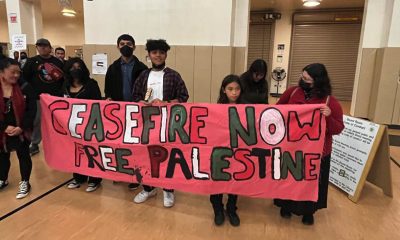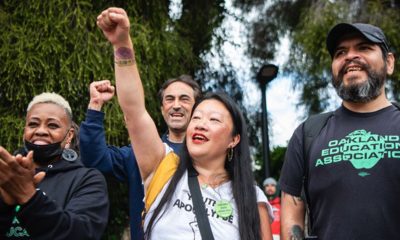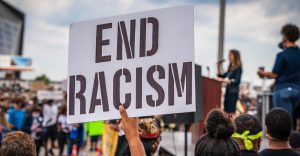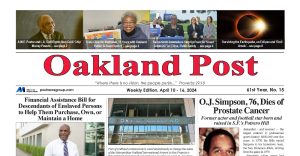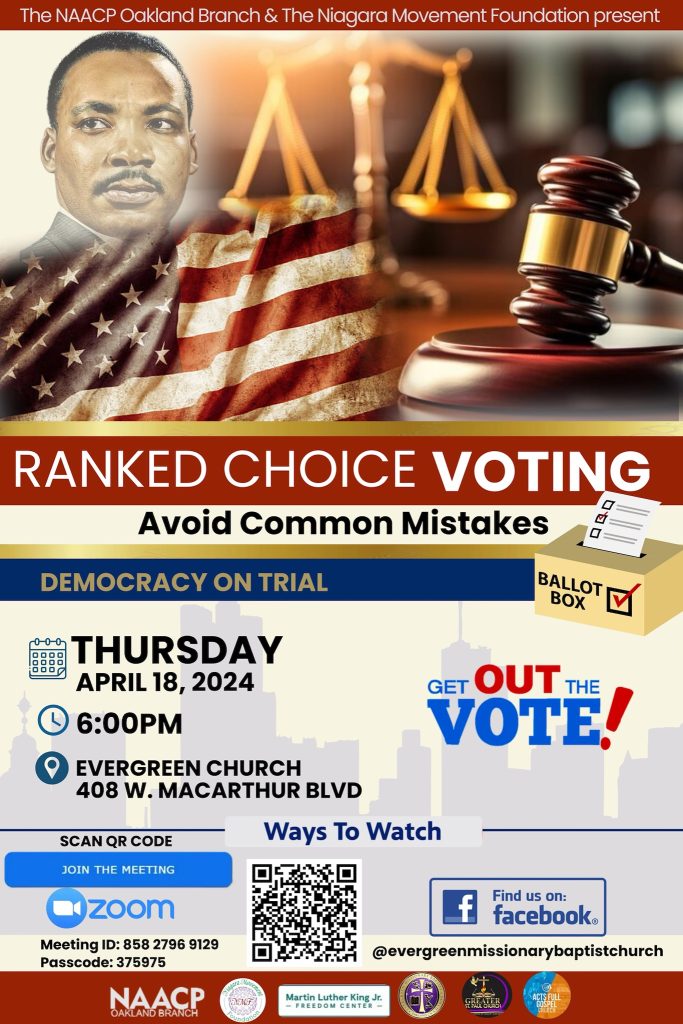Activism
‘Life Over Rent’ Rally Speakers Urge Tenants to Organize, Prepare next Steps
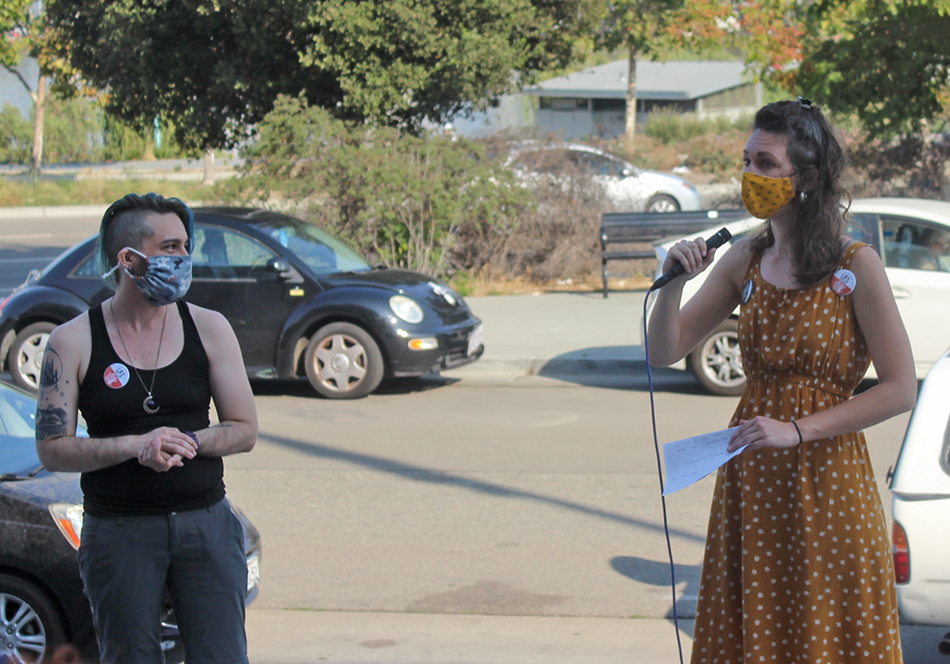
About 175 tenants gathered on the steps of Alameda County’s Superior Courthouse for a rally called Life Over Rent/Nuestrxs Vidas Si Renta No last Saturday.
A Facebook invitation for the rally claimed “Our needs come before our landlord’s profits” and showed that five different tenants’ unions organized the event: Tenants and Neighborhood Councils (TANC), SMC Tenants Council, Lonay Tenants Council, Village Residents Association at UC Berkeley Family Housing and JDW Tenants Union.
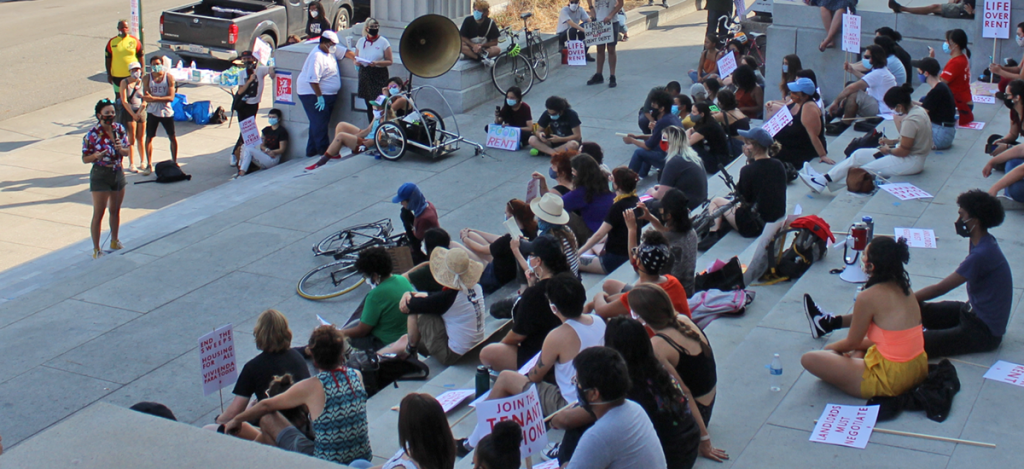
Jourdan Sales (far left) of JDW Tenants Union speaking to tenants at the Life Over Rent / Nuestrxs Vidas Si Renta No rally in front of the Alameda County Courthouse on September 5. Photo by Zack Haber
The invite also listed three goals: canceling rent during the pandemic, recognition and negotiation from landlords of collectively organized tenants, and prohibiting all evictions and expanding unemployment and food stamps for those hit hardest by the pandemic.
Although the day was hot with temperatures in the upper 80s and 90s, the courthouse provided shade where tenants sat in as they listened to about a dozen speakers representing different local grassroots tenant, labor, and housing justice groups.
A march was planned, but it was canceled as smoke increasingly blew into the area. Tenants held signs, mostly in red, some of which read “EVICTIONS = POLICE VIOLENCE,” “BLACK LIVES MATTER, BLACK TENANTS MATTER,” “HOMES FOR ALL, WE WON’T WAIT” and “LANDLORDS MUST NEGOTIATE.”
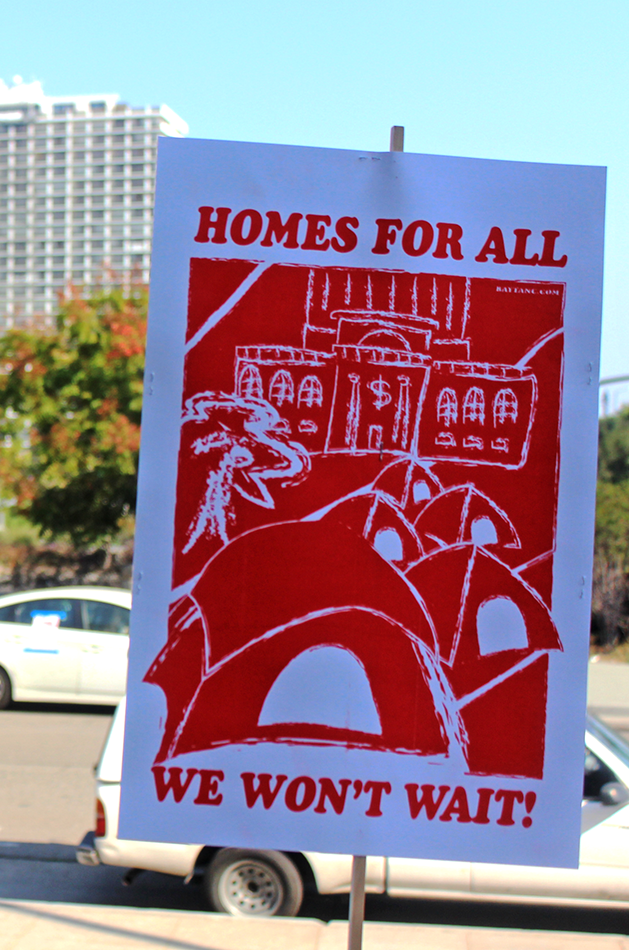
Photo by Zack Haber
Gerald Smith, a former Black Panther who’s currently a member of the Oscar Grant Organizing Committee spoke first and encouraged people to join in the fight to release people from San Quentin State Prison, where currently 26 people have died from COVID-19. Then Smith spoke of lessons he learned participating in The Harlem Rent Strikes in the mid-1960s and highlighted the importance of organized leadership and planning beyond small wins against landlords. After some landlords abandoned buildings during the Harlem strike, Smith said many renters weren’t organized or prepared on how to respond.
“We figured if you beat them, things are going to be all right,” Smith said. “But it’s not going to be all right. As long as capitalism exists it’s not going to be all right. You have to prepare people for the next step.”
Judy Greenspan, a local teacher and member of the Oakland Education Association spoke next and pointed out that COVID-19 could cause massive privatization of schools in addition to evictions if people do not organize well.
ILWU Local 34 president Keith Shanklin spoke against the Howard Terminal Project, which plans to place an Oakland A’s ballpark and market-rate condos in The Port of Oakland, and said it would destroy union longshoreman jobs.
Members of several local tenants’ unions including JDW Tenants Union, SMC Tenants Council and Alice Street Dunsmuir Tenant Union spoke of the need to connect and organize with other tenants, particularly ones who rent from the same landlord.
Jourdan Sales of JDW Tenants Union said her landlord, Justin Douglas Wallway, found a loophole he tried to use to remove rent control from more than 30 of the households he rented to in 2017. But through tenants organizing and collaborating with Centro Legal De La Raza, they were able to close the loophole.
“We actually changed housing legislation,” they said. “This battle took two years before it was won. This isn’t something that’s going to happen overnight. These things that we want to take time.”
Kieryn Darkwater and Casey Busher of Alice Street Dunsmuir Tenant Union spoke of how they have fought to stop their landlord from charging them for utilities they claim they are not legally obligated to pay. As their fight has been hung up in the Rent Adjustment Program and court, they have expanded and worked with the Ivy Hills Tenant Union.
Their landlord has refused to negotiate with them. Together, both groups have 25 units currently on rent strike. They’ve also started meeting regularly and have a bulletin board in their shared laundry room where they lend out tools and help each other with pet sitting.
“We have become our landlord’s worst nightmare,” said Darkwater.
Dayton Andrews of The United Front Against Displacement spoke of unifying unhoused and housed people together, dismantling distinctions between different struggles including housing, immigration, and queer rights.
“We have to come together as a class to oppose the enemies of the people,” said Andrews.
Activism
WOMEN IMPACTING THE CHURCH AND COMMUNITY
Juanita Matthews, better known as “Sister Teacher,” is a walking Bible scholar. She moved to California from the great state of Arkansas in 1971. Sister Teacher has a passion for teaching. She has been a member of Bible Fellowship Missionary Baptist Church since 1971.
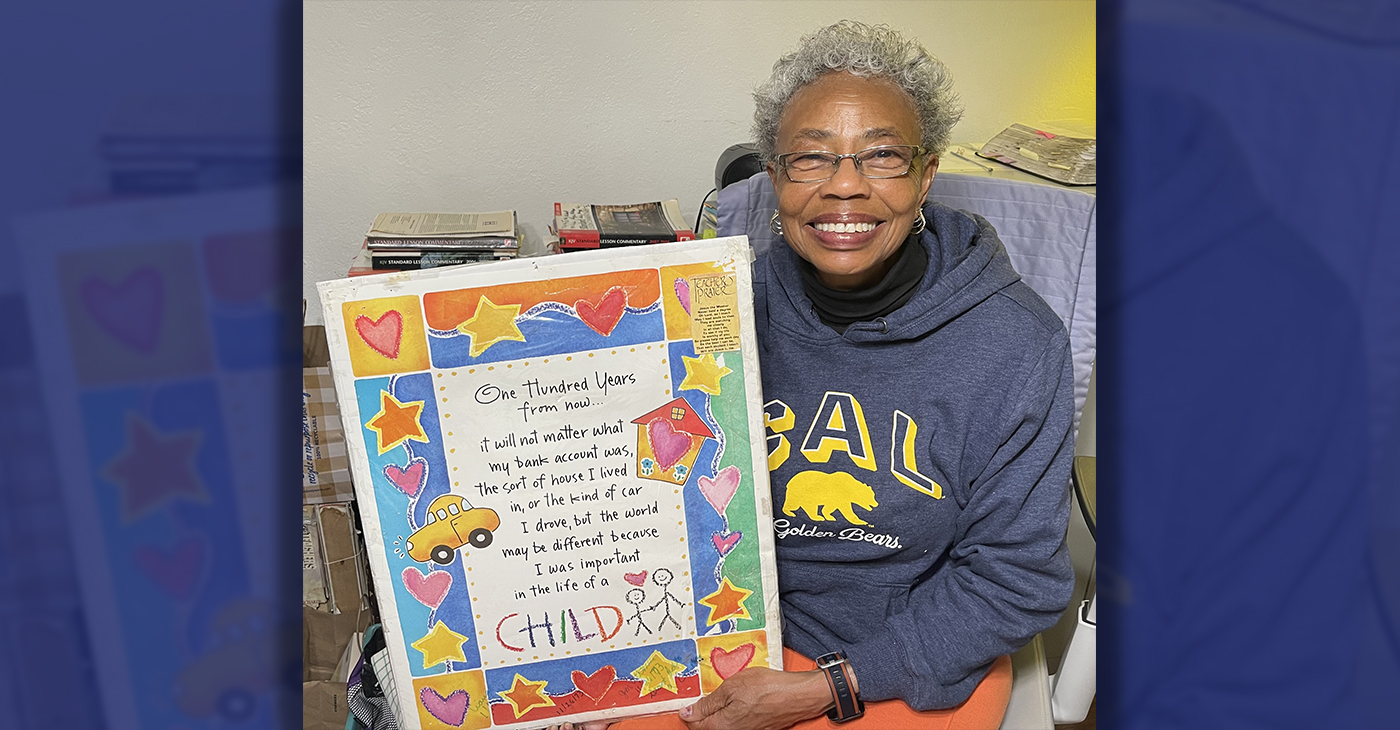
Sister Juanita Matthews
55 Years with Oakland Public School District
The Teacher, Mother, Community Outreach Champion, And Child of God
Juanita Matthews, better known as “Sister Teacher,” is a walking Bible scholar. She moved to California from the great state of Arkansas in 1971. Sister Teacher has a passion for teaching. She has been a member of Bible Fellowship Missionary Baptist Church since 1971. She followed her passion for teaching, and in 1977 became the lead teacher for Adult Class #6. Her motto still today is “Once My Student, Always My Student”.
Beyond her remarkable love for the Lord, Sister Teacher has showcased her love for teaching by working for the Oakland Unified School District for 55 years, all but four of those years spent at Emerson Elementary and Child Development School. She truly cares about her students, making sure they have the tools/supplies needed to learn either at OUSD or Bible Fellowship Missionary Baptist Church.
She’s also had a “Clothes Closet Ministry” for 51 years, making sure her students have sufficient clothing for school. The Clothes Closet Ministry extends past her students, she has been clothing the community for over 50 years as well. She loves the Lord and is a servant on a mission. She is a loving mother to two beautiful children, Sandra and Andre. This is the impact this woman of God has on her church and the community.
Activism
Oakland’s ‘Green the Church,’ Others, Host a Climate Revival
On April 20, Oakland’s Green The Church California (GTC) and the Center For Food, Faith and Justice will celebrate Earth Day and present a Climate Revival event titled “Growing Healthy Communities From Soil To The Soul” at McGee Avenue Baptist Church at 1640 Stuart St, Berkeley, CA. The day will include inspiring talks, interactive workshops, networking opportunities, and a special panel on Food Sovereignty and Global Food Resilience.
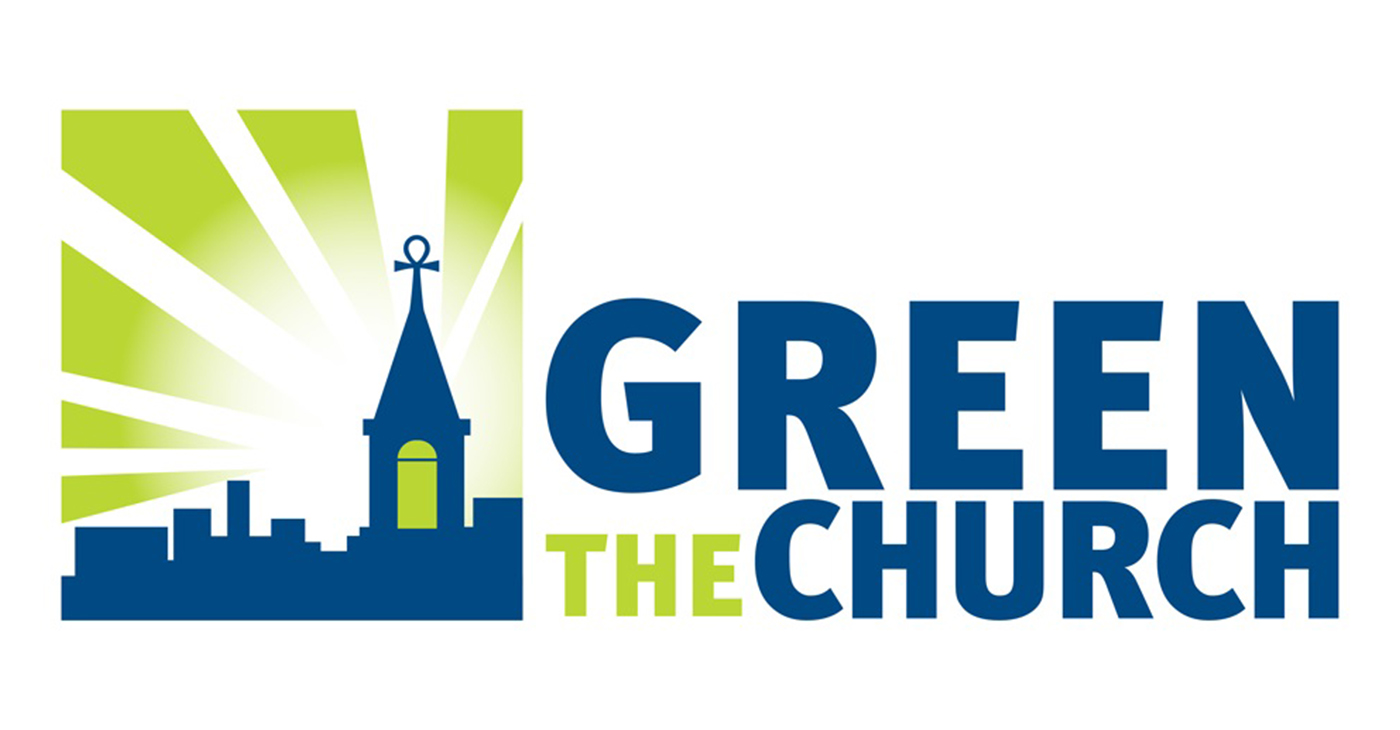
Growing Healthy Communities from Soil to the Soul in Berkeley
By Y’Anad Burrell
On April 20, Oakland’s Green The Church California (GTC) and the Center For Food, Faith and Justice will celebrate Earth Day and present a Climate Revival event titled “Growing Healthy Communities From Soil To The Soul” at McGee Avenue Baptist Church at 1640 Stuart St, Berkeley, CA,
The day will include inspiring talks, interactive workshops, networking opportunities, and a special panel on Food Sovereignty and Global Food Resilience.
The keynote speaker is Rev. Danté R. Quick, PhD, senior pastor of First Baptist Church of Lincoln Gardens in Somerset, N.J. Quick is well known in the Bay Area, having served for more than 10 years as pastor of Friendship Missionary Baptist Church in Vallejo, CA.
Green The Church, founded in 2010 by Rev. Dr. Ambrose Carroll, Sr., and headquartered in Oakland, helps galvanize Black churches and their local communities and leaders to address issues critical to populations historically disengaged from conversations around pollution and health, climate change, and sustainability and energy efficiency.
The organization collaborates with major environmental, sustainability, food security, faith, and community-based non-profit organizations, and is committed to “creation justice”—care and justice for God’s people and the planet—and building the Beloved Community.
Environmental justice has long been a pressing concern for communities of color who bear the brunt of pollution and ecological degradation. Climate change exacerbates these issues, disproportionately impacting vulnerable communities. Recognizing this urgency, Black churches across the country are taking action.
With deep roots in the African American community and its commitment to social justice, the Black Church has become an essential advocate for sustainable practices and policies.
Over the past 14 years, in a powerful collaboration with significant environmental, sustainability, food security, faith, and community-based non-profit organizations, GTC has created a cadre of Black churches engaging in the environmental justice, climate, and sustainability movement.
GTC presently works with more than 1,000 pastors and congregations across the U.S., and groups in the Bahamas, Ghana, Nigeria, and the UK, showing that we can make a difference together.
The partnership between environmental justice advocates and the Black Church extends beyond individual congregations. Green The Church provides resources and support for faith communities seeking to address climate change and promote environmental justice.
Through collaboration, initiatives such as energy efficiency programs, solar installations, and environmental education have been implemented in Black churches nationwide. These efforts reduce the carbon footprint and save money on energy bills, benefiting the congregations and their communities.
The involvement of the Black Church in the fight against climate change is not just a participation, it’s a powerful message that galvanizes action across communities.
By integrating environmental justice into their ministry, Black churches are demonstrating that addressing climate change is not only a matter of science but also of social and moral responsibility, inspiring change at a grassroots level.
For more information, go to: www.greenthechurch.org.
Activism
Oakland Post: Week of April 10 – 16, 2024
The printed Weekly Edition of the Oakland Post: Week of April 10 – 16, 2024
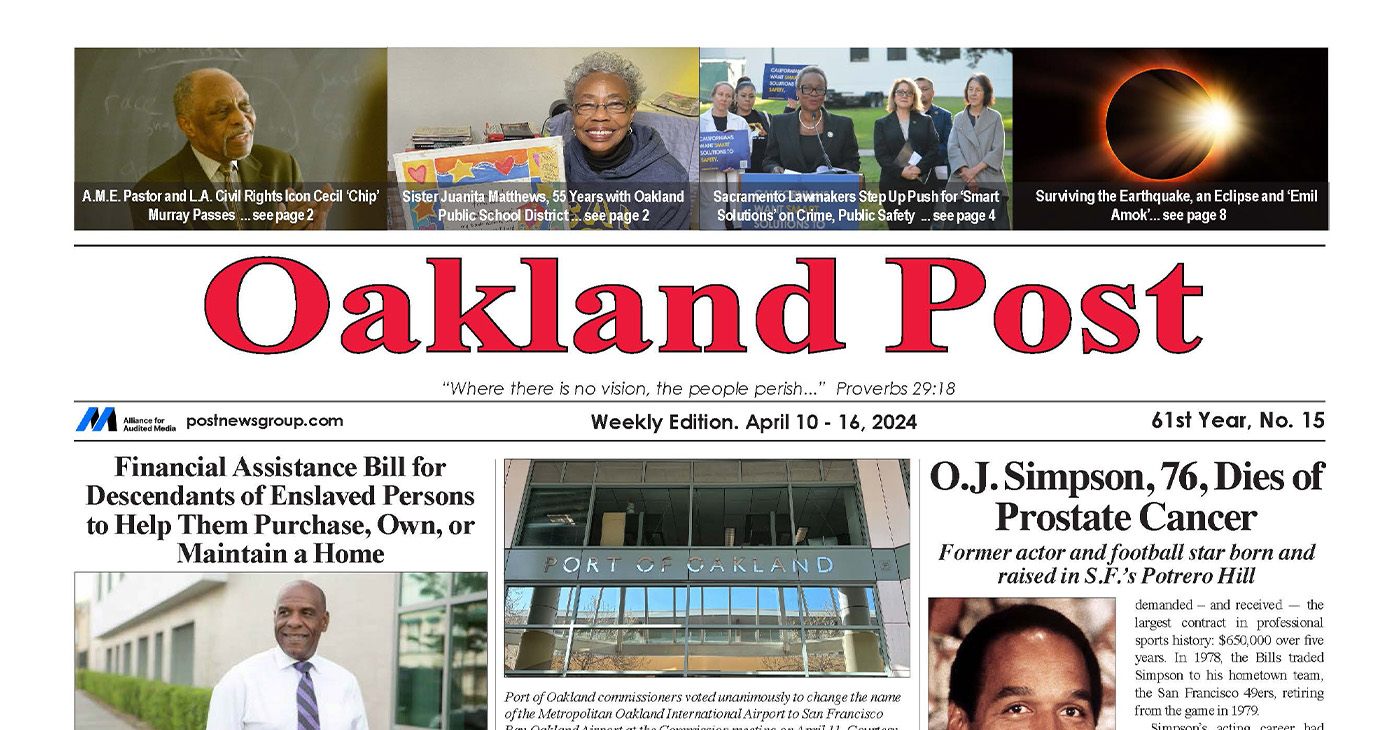
To enlarge your view of this issue, use the slider, magnifying glass icon or full page icon in the lower right corner of the browser window. ![]()
-

 Activism4 weeks ago
Activism4 weeks agoOakland Post: Week of March 20 – 26, 2024
-

 #NNPA BlackPress3 weeks ago
#NNPA BlackPress3 weeks agoCOMMENTARY: D.C. Crime Bill Fails to Address Root Causes of Violence and Incarceration
-

 #NNPA BlackPress3 weeks ago
#NNPA BlackPress3 weeks agoMayor, City Council President React to May 31 Closing of Birmingham-Southern College
-

 #NNPA BlackPress3 weeks ago
#NNPA BlackPress3 weeks agoFrom Raids to Revelations: The Dark Turn in Sean ‘Diddy’ Combs’ Saga
-

 #NNPA BlackPress3 weeks ago
#NNPA BlackPress3 weeks agoCOMMENTARY: Lady Day and The Lights!
-

 #NNPA BlackPress3 weeks ago
#NNPA BlackPress3 weeks agoBaltimore Key Bridge Catastrophe: A City’s Heartbreak and a Nation’s Alarm
-

 #NNPA BlackPress3 weeks ago
#NNPA BlackPress3 weeks agoBaltimore’s Key Bridge Struck by Ship, Collapses into Water
-

 Activism3 weeks ago
Activism3 weeks agoOakland Post: Week of March 27 – April 2, 2024

